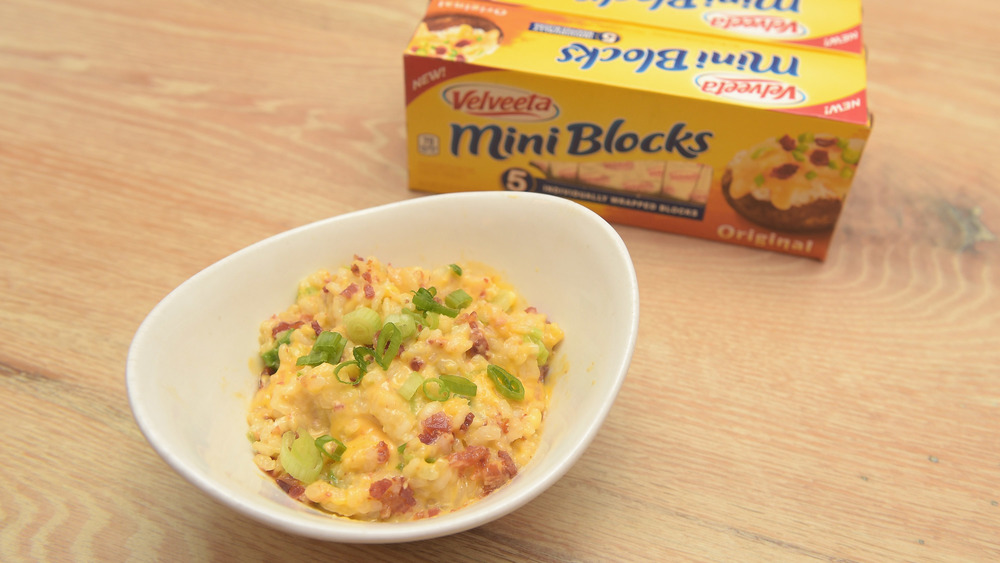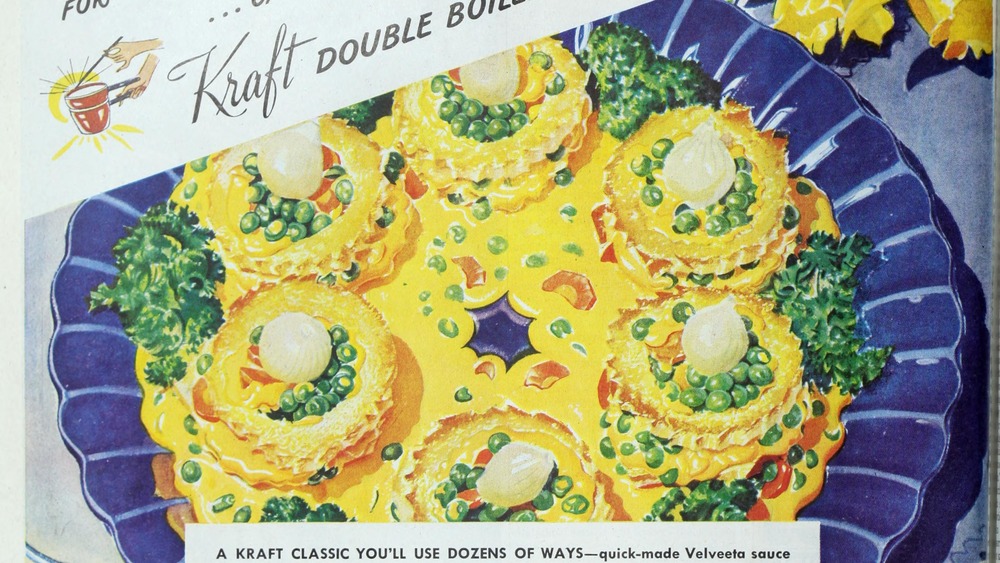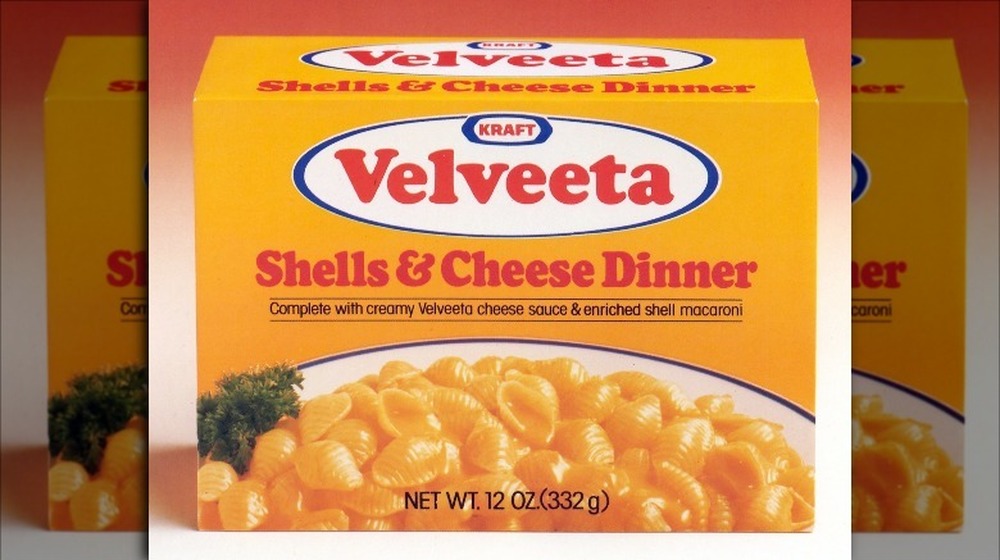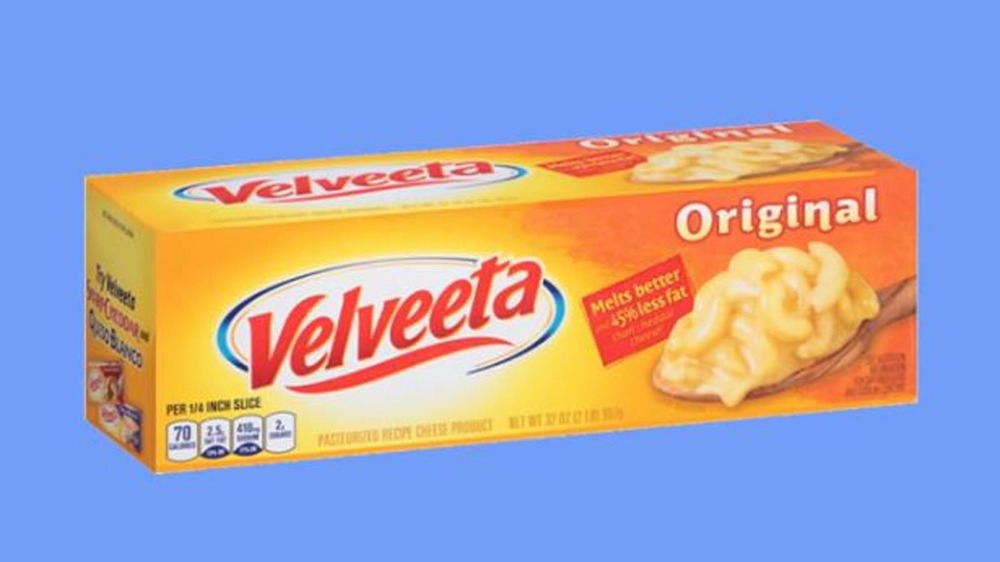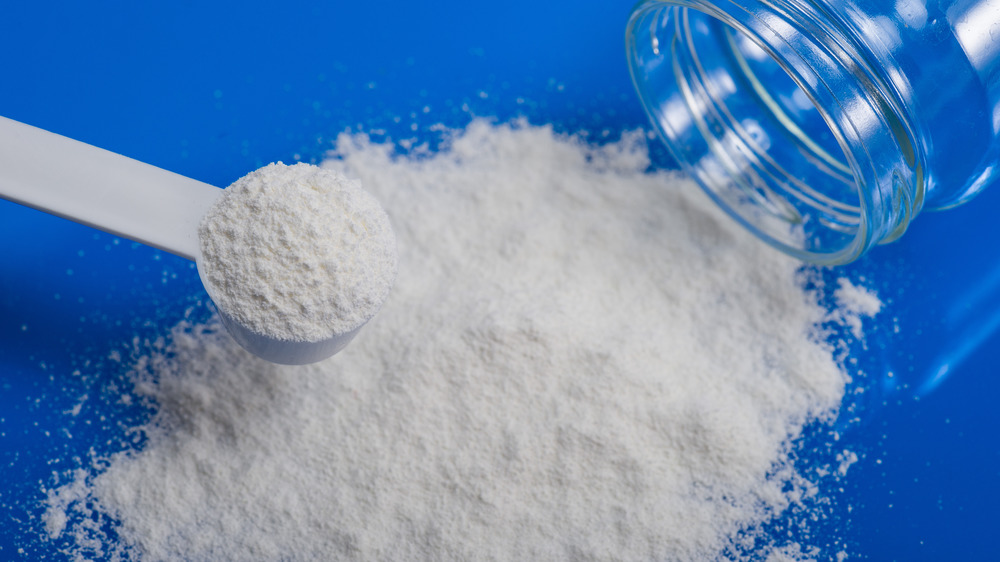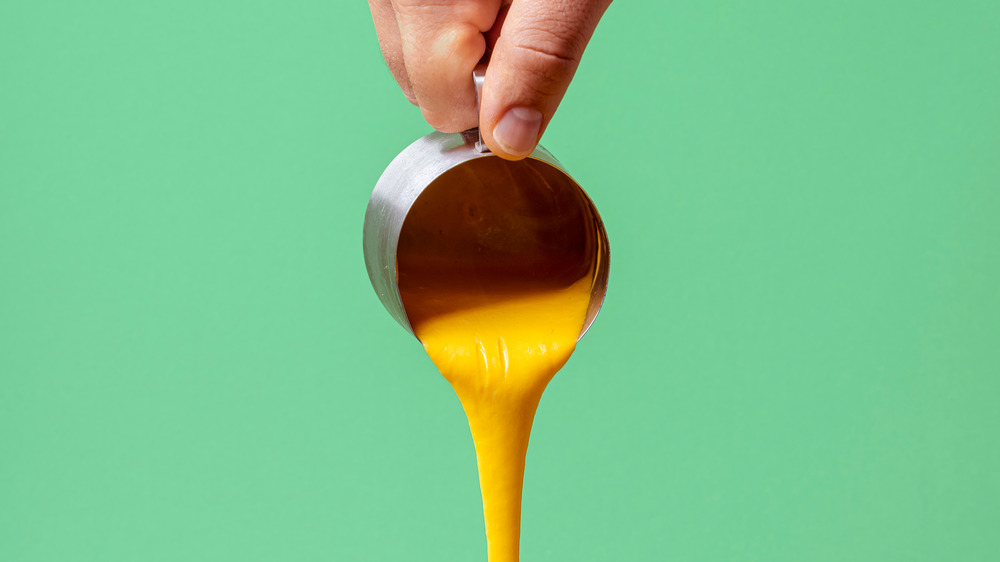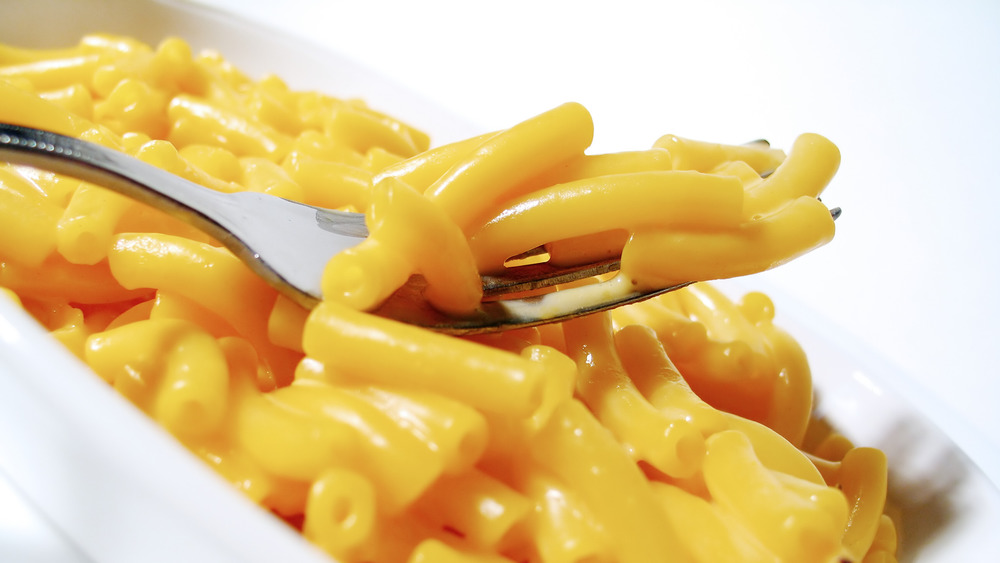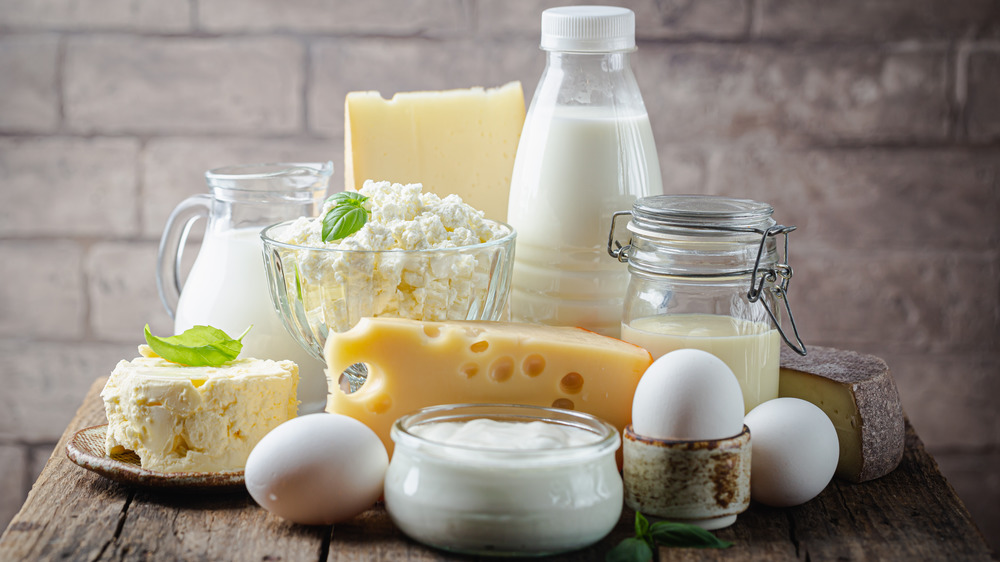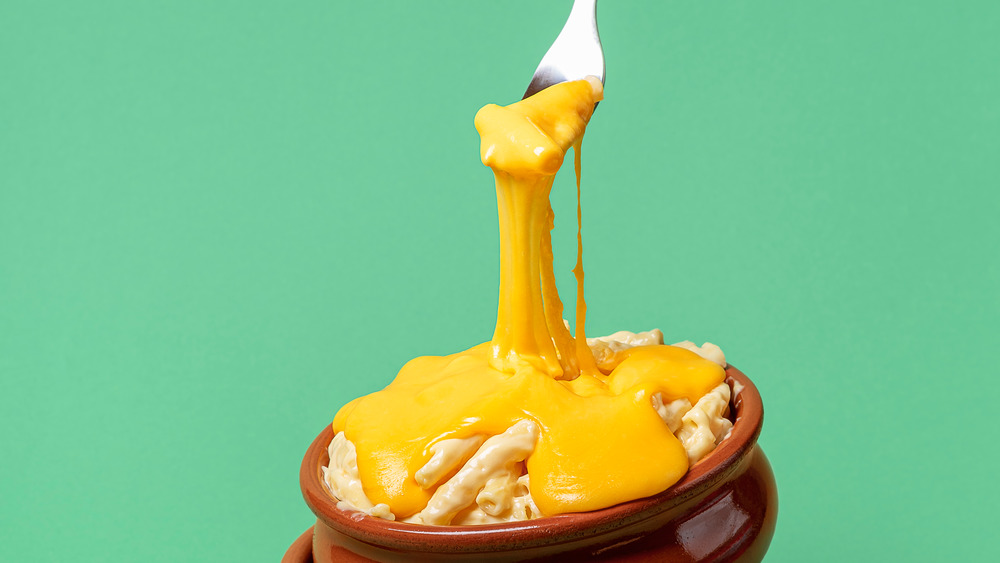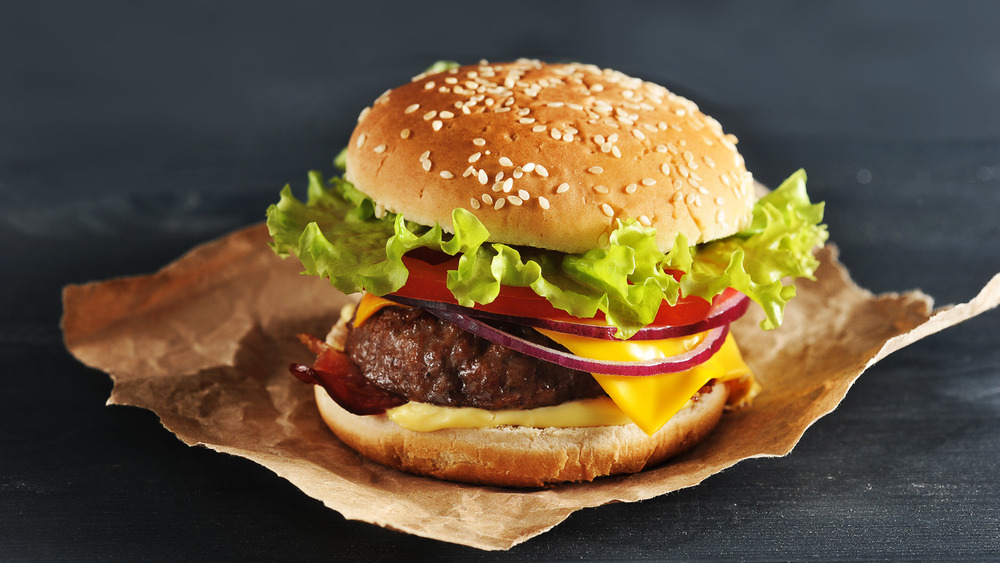This Is How Velveeta Is Really Made
Known as liquid gold, Velveeta is a bright orange-yellow block of salty, creamy deliciousness (at least to some) on grocery store shelves. It serves many purposes, from functioning as a smooth and creamy cheese sauce for homemade mac and cheese to gooey goodness inside a grilled cheese sandwich. It's also the base of many dips that are served at parties and social gatherings. No matter how much they claim to resist, few can resist a dish where Velveeta is the star of the show.
But how did Velveeta come to be and why is it sometimes so controversial? According to Delish, Velveeta was the brainchild of the Monroe Cheese Company. In the early 1900s, the cheese manufacturer didn't like to simply toss out its Swiss cheese wheels that were broken during the manufacturing process or ended up misshapen. Even if the wheels of Swiss weren't formed into a perfect circle, they were still edible. Throwing perfectly good food away seemed like a massive waste.
The company asked Emil Frey, a Swiss immigrant, to help out. Frey discovered that the scraps of cheese could be melted together with the help of whey and reused as a new product with a smoother consistency. Originally marketed under the Velveeta name as an independent New York company, the salvaged cheese bits became a hit when Kraft bought the company in 1927.
Since its debut, Velveeta's become a kitchen staple that's beloved and decried in equal measure. Here's how Velveeta is really made.
The history of Velveeta
According to Insider, J.L. Kraft, pioneer of Kraft Foods, had been toying with melting and reshaping chunks of discarded cheese before he came up with a number of processed cheeses that eventually became Kraft American Cheese, a close cousin to Velveeta. Food chemists discovered that all they had to do was grind up the leftovers and defective pieces and add an emulsifier to bind the pieces together. It earned the Velveeta name because the finished product had a smooth, velvety finish.
Velveeta falls under the classification of a pasteurized processed cheese, according to Michael Tunick a research chemist with the U.S. Department of Agriculture who wrote The Science of Cheese. Per Tunick and Insider, calling a produced "pasteurized processed cheese" means that it's a mix of older and fresh cheeses that are ground up into a single product. The U.S. Food and Drug Administration has specific rules regarding what can be labeled as a pasteurized processed cheese spread or a pasteurized processed cheese food. Manufacturers, therefore, have to follow strict guidelines on fat and moisture content and must be able to produce a product that melts at certain temperatures. Tunick himself confessed that Velveeta is something he would eat, but is "not going to be nearly as good as a regular natural cheese."
How exactly is Velveeta made?
A variety of orange-hued cheeses were originally used to concoct a rectangular slab of Velveeta, though the process has since changed somewhat. Using special machinery, as Insider reports, the chunks of leftover cheeses were ground up into small pieces, then an emulsifier designed to stabilize emulsions was added into the mixture. An emulsion is a dispersion or a mixture of two liquids that normally wouldn't play well together, like oil and water. "These liquids can be mixed together by force, like with a strong whisk or homogenizer," Food Crumbles reports.
The most common example of an emulsion is that of water and oils, like vinegar and olive oil. They can be mixed by hand, but once the action stops, the two antagonists will split again. While there are quite a few emulsifiers used in the food production process, common ones include egg yolks, egg proteins, mono- and diglycerides, esters with fatty acids, and polysorbates.
Now, that's how Velveeta used to be made, with emulsifiers and unused cheese pieces, but those aren't the ingredients used anymore. Because the manufacturing process for Velveeta has changed over time, many other factors had to change with it as well. This includes some legal updates, such as how the U.S. Food and Drug Administration classifies cheese products like Velveeta, which are now "pasteurized recipe cheese product" (via The Daily Meal).
What's really in Velveeta now?
Kraft has described Velveeta as able to melt into a texture that's "smooth and creamy for ultimate appeal," in glowing marketing terms (via Organic Authority). It melts so well and better than regular cheese because, well, it isn't real cheese. It certainly looks like cheese and can function as cheese in some respects, but still isn't actually the real thing.
As it approaches its 100th birthday, Velveeta is now made with whey protein concentrate and milk protein. The official list of ingredients as reported by Organic Authority include milk, water, whey, milk protein concentrate, milkfat, whey protein concentrate, and sodium phosphate. Velveeta also contains 2 percent or less of salt, calcium phosphate, lactic acid, sorbic acid, sodium citrate, sodium alginate, enzymes, apocarotenal, annatto, cheese culture.
The ingredient list for many kinds of cheese, by contrast, are simply milk, rennet, and salt. See the difference? Organic Authority says that whey isn't added to proper cheeses, because whey should already be produced during the traditional cheesemaking process. You may also have noticed that real cheese is often kept in the refrigerated section of the store and not on the shelf. While the USDA notes that not all cheeses have to be refrigerated, this is still a significant detail. But in the end, Velveeta is still considered quite delicious by its legion of fans regardless of the ingredients list.
Sodium citrate plays an important role in making Velveeta
Cheese food like Velveeta wouldn't be what it is today without sodium citrate, something that was discovered to transform cheeses decades ago. According to Discover, Swiss scientists and food tinkerers Walter Gerber and Fritz Stettler first shredded and melted Emmentaler, a yellow, medium-hard cheese named after the Swiss town where it was produced, and added it to a runny soup.
When the two ingredients made contact, the fat swam to the surface of the liquid and formed an unattractive and unpalatable layer of oil at the surface. But, when Gerber and Stettler added sodium citrate to the mix, the fat stayed put. They could then melt and cool the resulting cheese product into a form they could slice.
So, what exactly did sodium citrate have to do with all of this? Basically, the sodium citrate replaces calcium ions with sodium ions, making the casein proteins within the cheese bind with each other with less gusto. Those weakened bonds then result in the spongy, cheese-like block known as Velveeta. Sodium citrate also happens to give this spongy chunk of cheese food its impressive shelf life.
Velveeta was once promoted as healthy
Now that you know what all goes into the making of what you've either judged to be disgusting or yummy Velveeta, would it surprise you to know that it was once thought to be health food? Because protein-heavy whey is used to make Velveeta, Kraft marketed the thick yellowish-orange block of meltable goo in 1958 as something that would benefit the entire health-conscious family (via Mental Floss).
A black and white TV ad from that era described Velveeta as perfect for weight-watching adults, expectant mothers, and was even promoted as "extra good for youngsters", thanks to ingredients like protein, calcium, and phosphorous in the product. Back in 1931, Mental Floss reports, even the American Medical Association touted Velveeta as having "all the nutritional qualities to promote firm flesh."
Nowadays, however, one hopes that we've come a bit farther when it comes to judging healthy foods. And if you feel like you've knocked yourself back a dietary step by eating a Velveeta-based dish or splurging on a cheesy Velveeta dip, you could always take a jog. While you're doing so, you can pace yourself to the music performed by an '80s cover band from Pennsylvania called — what else? — Velveeta. Or consider the day you eat something made with Velveeta as a cheat day.
Velveeta can't legally be called cheese
Cheese historian and author Laura Werlin believes that the increase in cheese factories early in Velveeta's history — and, therefore, all that cheese-manufacturing competition — might be why the broken bits and misshapen wheels ultimately were saved to make Velveeta. "Cheese manufacturing was new, meaning that it was done on a much smaller scale prior. On a smaller scale, if you lose a little bit here and there, it still has an impact on you the producer, but when you see it coming off the line on a larger scale and there's all this waste piling up, maybe it seemed like, 'Wow, we're losing a lot here and it's time we try to think of something to do with it,'" she told Smithsonian Magazine.
But because Kraft changed its formula from using leftover cheese bits and misshapen cheese wheels to chemicals and whey, the U.S. FDA sent Kraft written notice to remove the words "cheese spread" from its packaging. Kraft was directed to use something more accurate: pasteurized prepared cheese product (via Organic Authority).
Still, nostalgia and convenience have kept Velveeta on the shelves of your local grocery store. "We as a culture have tended to gravitate toward foods that were—and are—predictable, unchanging and relatively bland," Laura Werlin told Smithsonian Magazine. "Processed cheese fit the bill and it is also easy to use."
Velveeta has hardly any calcium
Even though Velveeta is a cheese product, don't rely on it to meet your calcium needs. With the process used to make Velveeta, just one ounce meets just 13 percent of a person's daily value for calcium. However, a similar serving of cheddar cheese contains 20 percent, though it's also high in sodium like many other cheeses. But, it's worth noting that Velveeta does contain more lactose, a dairy sugar, than natural cheese.
According to Organic Authority, cheese doesn't actually contain that much lactose even though it's made with milk. That's because the natural cheese-making process encourages bacterial growth and removes much of the actors and helps convert the milk to cheese.
But since Velveeta isn't made like other cheeses, specifically natural cheese, it touts a 9.3 percent volume of lactose. Meanwhile, Swiss cheese contains 3.4 percent, Roquefort 2 percent, and Stilton 0.8 percent by volume of lactose. Meanwhile, cow's milk is typically comprised of 4.8 to 5.2 percent lactose. So while you're shoveling spoonful after spoonful of Velveeta shells and cheese in your mouth, you can at least pacify yourself with the thought that it at least contains quite a bit of lactose, which your body converts into valuable energy, as Yogurt Nutrition reports. Then again, all that lactose is a real problem for people who are lactose-intolerant, ultimately meaning you have to decide for yourself if Velveeta is worth it.
Some people prefer to make their own Velveeta
Lots of people love Velveeta and its flexibility, but they may also not like the ingredients used in its manufacturing process. So, they opt to create their own copycat version but with fewer ingredients. One of the most popular uses of Velveeta or Velveeta copycats is in a crockpot mixed with Ro-Tel diced tomatoes and chilies. According to Mental Floss, the dip was especially popular with President Lyndon Johnson and his life, the admittedly weird First Lady Ladybird, but didn't get truly popular until a canny marketing move in 2002 put Ro-Tel and Velveeta side-by-side in grocery stores.
If you're going to make your own Velveeta analog at home, you'll need to reach for a potentially surprising ingredient. NourishingJoy.com explains that gelatin is the key to a successful homemade Velveeta recipe. "Gelatin provides the velvety texture, the ability to melt and rechill, and it increases the protein content," NourishingJoy.com reports. Without this ingredient, it's possible that your homemade Velveeta just won't compare to the store-bought brand name stuff.
No, this recipe isn't especially heart-healthy, as it requires a fair amount of saturated fats in the form of cheeses, milk, and heavy cream. Still, for an occasional treat or a game-day snack, it's a good replacement for the oddly bright yellow-orange Velveeta you may have picked up otherwise.
Chefs tend to avoid Velveeta cheese products
Because of the abundance of artificial ingredients found in Velveeta, more and more restaurants are turning away from using processed cheese in their menu. In a surprising move, McDonald's issued a 2018 announcement that it would stop using artificial colorings and preservatives altogether, including processed cheese slices. Instead, the fast food chain has pledged to switch over to "real American cheese" using cheddar and colby without added preservatives, coloring, or fillers.
Chef Andy Jacobi agreed that processed cheese has no place on a self-respecting restaurant's menu. "There are so many great cheeses on the market right now," he told Vox. "It might take a few seconds longer on the griddle to melt, but that's because real cheese has texture and inconsistencies that make it taste so complex, which American cheese doesn't have."
Tia Keenan, a cheese specialist also interviewed by Vox, said that millennials, in particular, do not want to eat processed cheese anymore. They want real American cheese instead. "Processed cheese like Kraft Singles [...] are made from hydrogenated vegetable oil, and there are all kinds of ingredients in there that make it not cheese, which is why they're actually not allowed to call Kraft Singles cheese, legally." While previous generations have been able to handwave this matter, it seems that, beginning with millennials, future generations are far less enthusiastic about Velveeta and cheese products.
